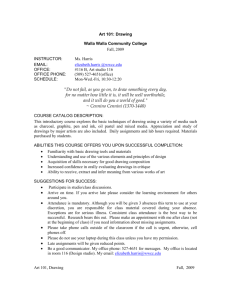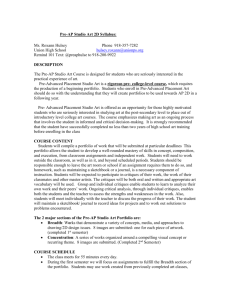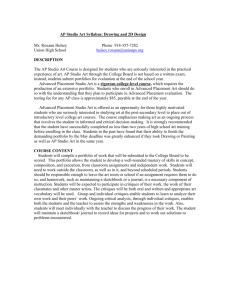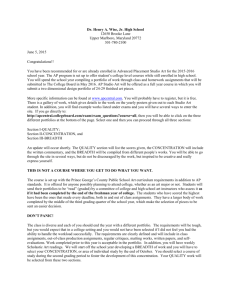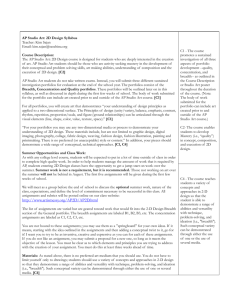Responsibilities
advertisement
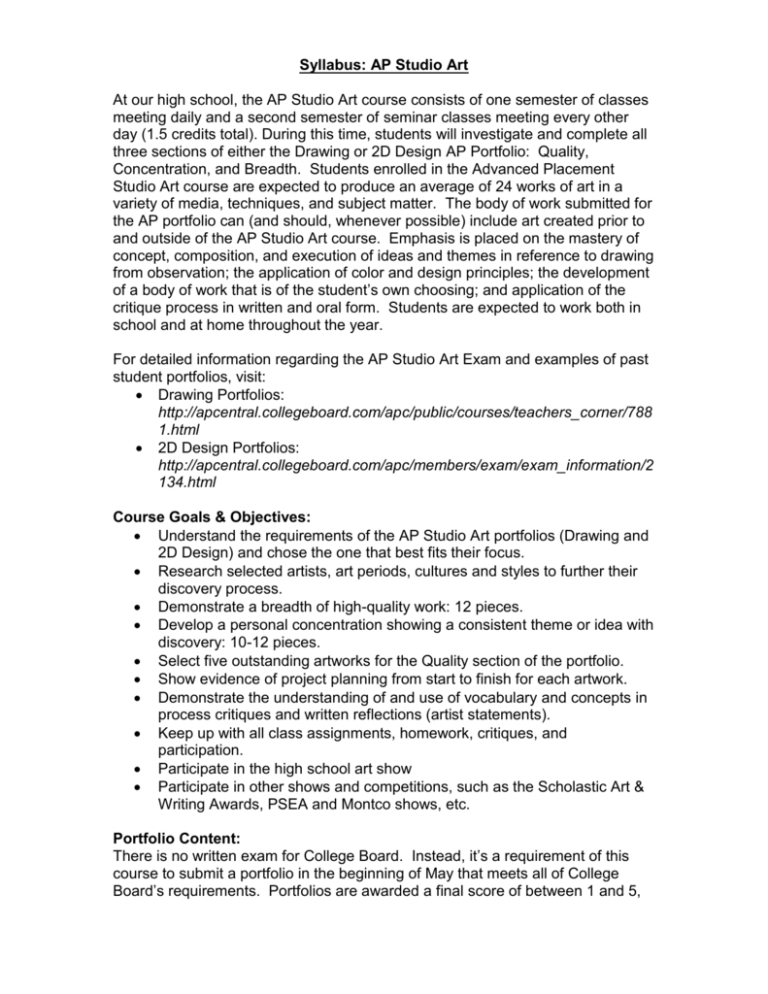
Syllabus: AP Studio Art At our high school, the AP Studio Art course consists of one semester of classes meeting daily and a second semester of seminar classes meeting every other day (1.5 credits total). During this time, students will investigate and complete all three sections of either the Drawing or 2D Design AP Portfolio: Quality, Concentration, and Breadth. Students enrolled in the Advanced Placement Studio Art course are expected to produce an average of 24 works of art in a variety of media, techniques, and subject matter. The body of work submitted for the AP portfolio can (and should, whenever possible) include art created prior to and outside of the AP Studio Art course. Emphasis is placed on the mastery of concept, composition, and execution of ideas and themes in reference to drawing from observation; the application of color and design principles; the development of a body of work that is of the student’s own choosing; and application of the critique process in written and oral form. Students are expected to work both in school and at home throughout the year. For detailed information regarding the AP Studio Art Exam and examples of past student portfolios, visit: Drawing Portfolios: http://apcentral.collegeboard.com/apc/public/courses/teachers_corner/788 1.html 2D Design Portfolios: http://apcentral.collegeboard.com/apc/members/exam/exam_information/2 134.html Course Goals & Objectives: Understand the requirements of the AP Studio Art portfolios (Drawing and 2D Design) and chose the one that best fits their focus. Research selected artists, art periods, cultures and styles to further their discovery process. Demonstrate a breadth of high-quality work: 12 pieces. Develop a personal concentration showing a consistent theme or idea with discovery: 10-12 pieces. Select five outstanding artworks for the Quality section of the portfolio. Show evidence of project planning from start to finish for each artwork. Demonstrate the understanding of and use of vocabulary and concepts in process critiques and written reflections (artist statements). Keep up with all class assignments, homework, critiques, and participation. Participate in the high school art show Participate in other shows and competitions, such as the Scholastic Art & Writing Awards, PSEA and Montco shows, etc. Portfolio Content: There is no written exam for College Board. Instead, it’s a requirement of this course to submit a portfolio in the beginning of May that meets all of College Board’s requirements. Portfolios are awarded a final score of between 1 and 5, with 5 being the highest quality. A score of 3 or higher will earn college credit at many participating universities. To find participating universities, visit: https://apstudent.collegeboard.org/creditandplacement/search-credit-policies. Each type of portfolio consists of 24 total images representing three sections: Quality, Concentration, and Breadth. BREADTH: Submit 12 digital images of 12 different artworks. You must show your experience with a variety of concepts and approaches that demonstrate your abilities, range, and versatility with different techniques, media, problem solving, and imagery (methods and concepts vary between Drawing and 2D Design portfolios). CONCENTRATION: Submit 12 digital images of between 10-12 artworks (a maximum of 2 images may be details or close-ups) investigating an idea or theme that has personal interest to you. You’ll create a body of cohesive work showing an in-depth understanding and exploration of your idea. There is a written component called a “commentary” where you’ll describe the theme of your concentration and how it evolved. A written commentary must accompany the work in this section. QUALITY: Submit 5 actual artworks that you consider your “best’ (these pieces will come from your Breadth and Concentration sections). None may be larger than 18” x 24”. In this section, you do not need to show a variety of techniques or approaches, just your 5 very best pieces. Assessment and Evaluation: *Instructor may make ongoing adjustments to this portion of the syllabus. AP Studio Art grades will consist of: Summer Assignments: 185 pts. total Major Course Projects: 30 pts. each Process Critiques: 5 pts. each Several Artist Statements: 5 pts. each Worksheets, Exercises, Activities, Quizzes: points vary Final Exam- 20% of semester grade For major course projects, students are graded with criteria adapted directly from College Board’s scoring guidelines. For each set of criteria on the project rubric, students will earn a score on a scale of 1-5 that most closely reflects the grade they’d earn from college board readers. “AP Exam scores of 5 are equivalent to A grades in the corresponding college course. AP Exam scores of 4 are equivalent to grades of A–, B+ and B in college. AP Exam scores of 3 are equivalent to grades of B–, C+ and C in college” (AP Studio Art Curriculum; College Board, p. 2). Therefore, if a student’s work is submitted on time and consistently earns a grade of A from the instructor, they should expect to receive a score of 5 for their portfolio from College Board. Likewise, if a student consistently earns anywhere from a B to an A-, they should expect to receive the score of 4. It is important for students and parents to understand that to realize that the level of rigor in this course is much higher than in previous Art Major courses, and while strong effort and dedication will likely produce higher-quality work, they do not necessarily equate to an ‘A’ or ‘B’ grade on an AP-level assignment. Due Date Policy: All projects and assignments must be submitted within the first 10 minutes of class on the due date. Assignments will be subject to a lateness penalty of 10% for each class period overdue. If a student has an excused absence from school on the due date of a major project, they must submit the project at the beginning of class the next day or be subject to a late penalty for both days. If a student has more than 2 excused absences on major project due dates within a semester, one of the following must happen: From that point forward, projects must arrive (be dropped off) at school by the beginning of the class period on the due date, or the parent/guardian must make contact with the instructor to validate the absences. Classroom Participation: Students must spend the entire period working on assignments for AP Studio Art only (you’ll need it!). Students who spend class time on endeavors unrelated to this course will lose points on the Project-Planning portion of the major project rubric for the subsequent assignment. Students are expected to be in the room and beginning to work right when the bell rings. More than four latenesses to class will result in a disciplinary write-up. Work Ethic Outside of Class: Students will spend most of their time working on AP assignments outside of class time. The only assignment they’ll need to work on in school is the Glass Still-life Study, because it’s a life drawing (they may stay after school until 5pm each day, and also use DS time). If students have other extracurricular activities, work responsibilities, etc., they will need to work extra hard to plan their time accordingly. This is a rigorous, college-level course, and deadlines will not be adapted on an individual basis due to extracurricular involvement. It is a student’s responsibility to manage their time accordingly. Artistic Integrity: Artistic Integrity is of the utmost importance in AP Studio Art. Students are not allowed to copy published photographs. Work from photographs or from other artists must be manipulated beyond mere duplication. Work must show an elaboration of the photograph or idea to the personal extent of the student artist. Students and parents sign an Honor Code at the beginning of the course documenting their understanding of artistic integrity. When the instructor signs off on a student’s AP portfolio, they are vouching for the integrity of a student’s portfolio. This is an important reason why students must work consistently in class so the instructor sees evidence of their progress on assignments. Use of Sketchbooks: Sketchbooks are used on a daily basis as a visual journal to work through ideas, to practice drawing as well as compositional skill and to document the development of ideas. Sketchbooks will be checked periodically, and with each project submission. Critiques: Critiques are held on a weekly basis (process and final critiques), usually on a Tuesday, to give students the ability to reflect on their own work as well as the work of their peers. Critiques are a combination of formal, informal, group and one-on-one critiquing styles. All students are required to participate. Artistic and aesthetic vocabulary and terminology will be used in all critiques. It was initially introduced in the Art Major courses and is reinforced throughout the AP critiquing process. Process Critiques During the process critique, students must justify their thumbnail sketches and color experimentations in front of their peers. Student presentations address subject, content, composition, positive and negative space, color theory and the dominant Element and Principles of Design. Constructive criticism must provide solutions to the problems being addressed. Final Critique (Second chance learning) The final critique reflects changes validated during the process critique. Problems related to the AP scoring criteria can still be addressed during this session. The remainder of the week outside of class (Wednesday, Thursday, and Friday), is spent adding final touch-ups. All projects are to be handed in that Friday for grading. This policy is subject to change for any reason. Course Outline: Quarter Q1 (Sept. – Nov.) Q2 (Nov. – Jan.) Q3 (Feb. – Apr.) Q4 (Apr. – May) Overview of Course Content A series of teacher-initiated assignments will be presented exposing students to a wide range of experiences in drawing together with high-level problem-solving skills. By the end of November, students will have created a comprehensive body of artwork suitable for the Breadth Section of their AP Studio Art Portfolio. Assignments will be staggered so that students will be working on more than one assignment at a time. Q1 assignments include (subject to change): Glass Still-life Intimate Portrait (Drawing); Geometric Abstraction (2D Design) Game of Life Fruit/Veggie/Nature Study Hand/Foot Study (HW) Line-Value Study (HW) The concentration is a body of related works based on an individual’s interest in a particular idea expressed visually. It focuses on a process of investigation, growth, and discovery. Students are encouraged to explore a personal, central interest as intensively as possible, and are free to work with any medium. However, the concentration should grow out of, and demonstrate, a plan of action or investigation in which the student has invested considerable time, effort, and thought. Students will be evaluated not only in the work presented but also in visual evidence that the student has thought out and pursued a particular project or way of working. Students will submit an artist statement/reflection with each project. Q2 assignments include: Written explanation of concentration Concentration Piece #1 Concentration Piece #2 Concentration Piece #3 Concentration Piece #4 Concentration Piece #5 AP Seminar- This is an independent study where students fill in the gaps in their portfolios. They will submit a project every 1.5 weeks for either their Breadth or Concentration sections. Continuation of AP Seminar; Uploading of portfolio images to College Board’s Digital Submission website; Digital submission of portfolios; Submission of quality section of portfolio. For Additional Information: Contact the teacher at: Leconomo@hatboro-horsham.org Visit the teacher’s website at: http://www.hatboro-horsham.org/Page/9269 Visit College Board: Drawing Portfolios: http://apcentral.collegeboard.com/apc/public/courses/teachers_corner/788 1.html 2D Design Portfolios: http://apcentral.collegeboard.com/apc/members/exam/exam_information/2 134.html ADVANCED PLACEMENT STUDIO ART CONTRACT The purpose of an Advanced Placement class is to help students prepare of college. At the same time it gives the student the opportunity to place out of certain college courses, thus saving time and money. The class will be taught at a faster pace than the normal high school art course with higher level thinking skills and outside projects and readings. The grading process will also be more rigorous than students were accustomed to in Art Major courses. Because of the nature and rigor of the course, it is important that the teacher, student, and parents/guardians agree to commit the time and energy needed to complete the course successfully. This class will be conducted under an honor code. All students will be expected to do their own artwork. At times, students will be given projects that must be completed outside of class. All work must be original. Copied artwork is unacceptable under copyright laws. If a student breaks this code, it will give him or her an unfair academic advantage and may result in the student being removed from the course. Responsibilities: Teacher: I agree to help students prepare for AP Portfolio submission by making new information available to them and teaching them the necessary skills to prepare their portfolios. I shall make parents aware of any learning or disciplinary problems that may arise so that by working together, we may resolve them. Teacher’s Signature ___________________________________ Date: ___________ Student: I am aware of the criteria for AP Studio Art, and I agree to accept the responsibility for the preparation needed to complete the Advanced Placement course and portfolio. I will participate over the summer and in class in all course requirements, including major projects, written work, and providing constructive feedback to classmates in critiques. Student’s Signature ___________________________________ Date: ___________ Parent /Guardian: I am aware of the criteria for AP Studio Art, and I agree to help my child work to be successful in this college-level course. I will help my child organize study time and encourage my child when the pressures of the class begin to build. I will promptly communicate any concerns with the teacher about the course or any learning problems that need to be addressed. I understand and accept that students will be viewing and producing college-level materials, and thus dealing with issues and visual materials that may be controversial. I accept that per the level of rigor necessary for a college-level course, the grades my child earns on major assignments will reflect College Board’s scoring criteria and will thus not necessarily be indicative of the amount of time and effort dedicated to an assignment. Parent/Guardian’s Signature_____________________________ Date: ___________ Communication: It’s important that the teacher have the ability to communicate with students and parents/guardians throughout the course. Please provide a current email address that I can use to contact you if necessary. Don’t hesitate to contact me with questions or concerns at: Leconomo@hatboro-horsham.org Please allow 24 hours turnaround time for a response (48 hours on weekends). Student Email Adress: ___________________________________ Parent/Guardian Email Adress: ___________________________________ Throughout the semester, I will be sending reminders of upcoming deadlines to students via text message or email alerts using Remind101.com. Your child is required to sign up via either text messaging or email (If your child does not have a cell phone, they can sign up with their school email address. Standard text messaging rates also apply). Many parents have found this to be an efficient method for keeping up with their child’s schoolwork. If you’d like to help your child manage their AP course deadlines, I encourage you to sign up. Please check one of the options below to notify me if you’ll be signing up: ________ I will sign up for Remind101 alerts to help my child stay on-task with deadlines. ________ I will not be signing up for Remind101 alerts at this time. To subscribe to Remind 101 for this course, visit this link and follow instructions: https://www.remind101.com/join/apartf14

